Pad Thai: Authentic Thai Street Food Recipe

Ever wondered why your homemade Pad Thai doesn’t taste like street vendors in Thailand? Authentic Thai food is known for its bright flavors. Pad Thai is a perfect mix of sweet, salty, and sour, making your taste buds feel like you’re in Bangkok. But how can you get that real taste at home?
We’ll show you an easy recipe for traditional Pad Thai. You’ll learn about key ingredients like tamarind paste, fish sauce, and the right rice noodles. Follow our guide to make this beloved street food in your kitchen, just like in Thai stalls.
What Is Pad Thai?
Pad Thai is a famous dish in Asian Cuisine. It’s loved for its mix of flavors. This dish has sweet, sour, and savory tastes.
It uses tamarind paste and fish sauce. These make Pad Thai special. Every part of it, like the noodles and sauce, makes it unique.
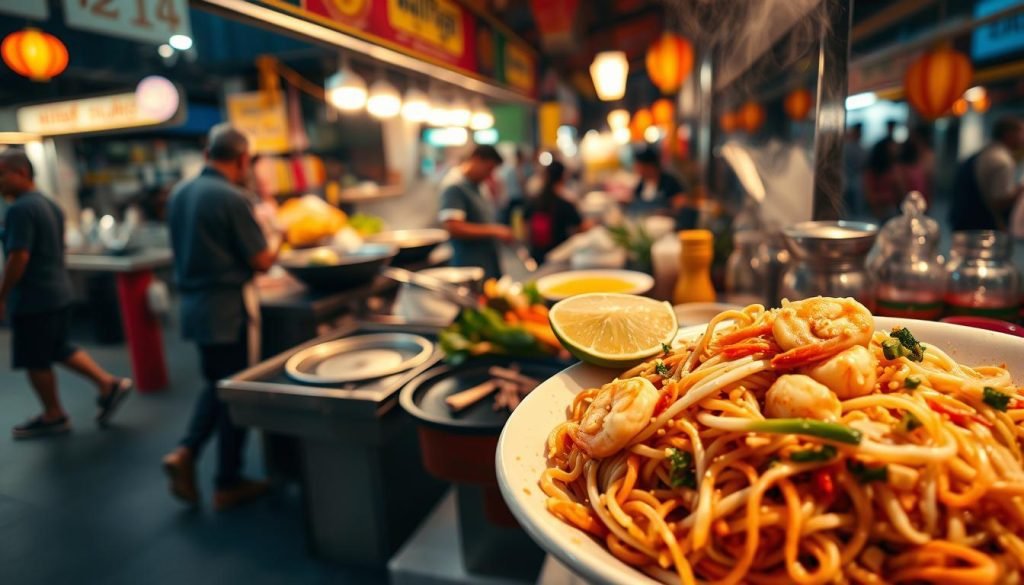
A Brief History of Pad Thai
Pad Thai started in the 1930s. It was during a time when Thailand was building itself. The country had a rice shortage during World War II.
The government wanted to save rice. They suggested eating noodles instead. Pad Thai has Chinese roots, like other noodles in Southeast Asia.
It was made to show Thailand’s identity through food. Today, it’s loved worldwide. CNN Go named it one of the world’s best foods in 2011.
Ingredients That Make Pad Thai Unique
Pad Thai’s flavor comes from special ingredients. Here’s what makes it authentic:
| Ingredient | Amount |
|---|---|
| Chang’s Pad Thai dried rice sticks | 125 g (4 oz) |
| Tamarind puree | 1.5 tablespoons |
| Brown sugar (packed) | 3 tablespoons |
| Fish sauce | 2 tablespoons |
| Oyster sauce | 1.5 tablespoons |
| Vegetable or canola oil | 2–3 tablespoons |
| Beansprouts | 1.5 cups |
| Chicken breast | 150 g (5 oz) |
| Firm tofu | 0.5 cup, cut into 3 cm batons |
| Garlic chives | 0.25 cup, cut into 3 cm pieces |
| Finely chopped peanuts (for garnish) | 0.25 cup |
These ingredients make a dish for 2–3 people. It takes about 30 minutes to make. Thai noodles are key, giving it a chewy texture.
With a 4.95 out of 5 rating from 398 votes, Pad Thai is a favorite. It’s full of flavor and true to Thai cooking.
Essential Ingredients for Pad Thai
To make a real Pad Thai, you need to know about flavors and ingredients. We’ll look at the dish’s core, protein choices, and key veggies that tie it all together.
Noodles: The Heart of the Dish
Thai noodles are key in Pad Thai. You’ll need 8 ounces of flat rice noodles for the right chew. Soak them for 20 to 30 minutes before cooking. This makes them tender but still firm.
These noodles soak up the sauce well. The sauce is made from fish sauce, soy sauce, sugar, vinegar, and a bit of Sriracha.
Proteins: Tofu, Shrimp, or Chicken?
Choosing a protein changes the taste and fits different diets. For a Vegetarian Pad Thai, tofu is great. It soaks up flavors well.
For seafood fans, Shrimp Pad Thai with 1 pound of shrimp is tender and tasty. Chicken Pad Thai with 8 ounces of chicken is also popular. Each protein adds its own flavor to the dish.
Vegetable Additions
Vegetables like bean sprouts, red bell peppers, and green onions add color and crunch. Use 1 cup of bean sprouts, a red bell pepper, and chopped green onions. Chopped peanuts and cilantro add texture and taste.
These veggies make the dish colorful and nutritious. They add a lot to the flavor and health of Pad Thai.
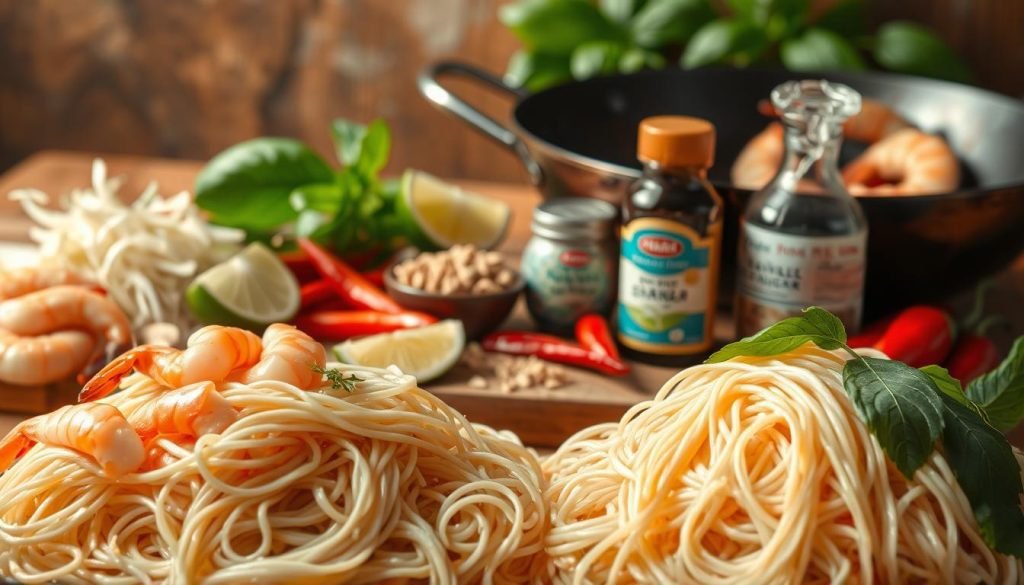
| Ingredient | Quantity | Preparation Notes |
|---|---|---|
| Flat Rice Noodles | 8 ounces | Soak for 20 to 30 minutes. |
| Oil | 3 tablespoons | Divided for cooking. |
| Garlic | 3 cloves | Finely chopped. |
| Shrimp, Chicken, or Tofu | 8 ounces | Choose one based on preference. |
| Eggs | 2 | Lightly beaten. |
| Bean Sprouts | 1 cup | Fresh. |
| Red Bell Pepper | 1 | Thinly sliced. |
| Green Onions | 3 | Chopped. |
| Dry Roasted Peanuts | 1/2 cup | Coarsely chopped. |
| Limes | 2 | Cut into wedges. |
| Fresh Cilantro | 1/2 cup | Chopped. |
How to Make Authentic Pad Thai
Making traditional Pad Thai needs some key cooking techniques. You must know how to handle rice noodles. Follow these steps to make a dish that’s true to its roots. It will have all the ingredients in perfect balance for a tasty meal.
Preparing the Noodles
Start by getting your rice noodles ready. They should be about 1/4 inch wide. Soak them in lukewarm water for 5-6 minutes until they’re soft. Don’t boil them to avoid breaking and clumping.

Cooking the Ingredients
After the noodles are ready, start cooking the ingredients. You’ll need 3 tablespoons of peanut oil. You can also use avocado or coconut oil if you like. Choose thinly sliced chicken breast, shrimp, or tofu for protein.
- Heat the oil in a hot wok.
- Add your protein choice and stir-fry until it is about 70% cooked.
- Move the proteins to one side of the wok and crack 2 large eggs into the other side, scrambling them quickly.
The Stir-Fry Process
The stir-fry is key to mixing all Pad Thai elements. Add the noodles and pour the authentic Pad Thai sauce. The sauce has 5 tablespoons of Thai fish sauce, 2 tablespoons of palm sugar, and 70ml of tamarind paste.
- Toss the noodles continuously for about 2 minutes to ensure they absorb the sauce.
- Add a handful of bean sprouts and 5 chopped green onions, mixing them into the noodles.
- Allow the sauce to caramelize in the wok for approximately 30 seconds to deepen the flavors.
Cook in smaller batches to prevent overcrowding. This helps your noodles crisp up perfectly. Finish with crushed roasted peanuts, fresh bean sprouts, Thai chili flakes, and lime wedges for a real touch.
| Ingredients | Quantity |
|---|---|
| Rice Noodles | 7oz (200g) dried or 14oz (400g) fresh |
| Peanut Oil | 3 tablespoons |
| Protein (Chicken, Shrimp, or Tofu) | 8oz (225g) |
| Eggs | 2 large |
| Pad Thai Sauce | 1/4 cup (70ml) |
| Bean Sprouts | 1½ cups (150g) |
| Green Onions | 5, chopped |
With practice, you’ll make an authentic Pad Thai at home. Each bite will be full of flavor and tradition.
Common Variations of Pad Thai
Pad Thai is loved all over the world. It has many versions for different tastes and diets. You can find it in Bangkok’s streets and in American restaurants.
Vegetarian and Vegan Options
For those who eat plants, *Vegetarian Pad Thai* and *Vegan Pad Thai* are great choices. They don’t lose flavor. Traditional Pad Thai has fish sauce and eggs, but you can change these for plant-based diets.
- Vegetarian Pad Thai: This version keeps eggs for protein. It’s good for lakto-ovo vegetarians. It has crushed peanuts and veggies like bean sprouts, carrots, and bell peppers.
- Vegan Pad Thai: For vegan, just leave out the eggs. Use soy sauce or tamari instead of fish sauce. Add tofu or tempeh for protein. Tamarind paste and cane sugar keep it sweet and sour.
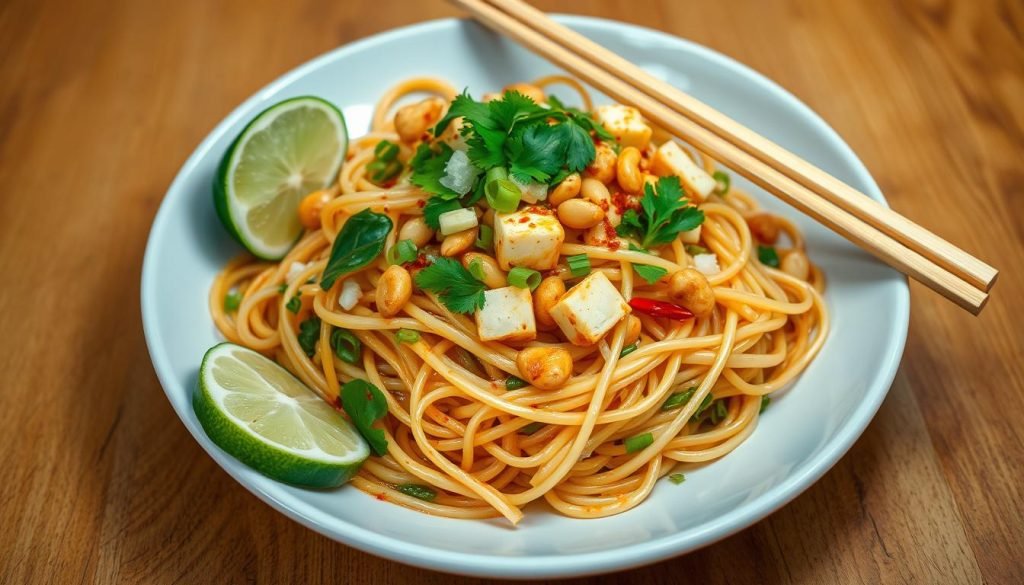
Regional Differences in Recipe
Pad Thai changes a lot depending on where you are in Thailand or the world. These *Regional Asian Cuisine* differences show local tastes and ingredients. Pad Thai has many faces.
- Central Thailand: This area’s Pad Thai is well-known. It has rice noodles, tamarind sauce, and proteins like shrimp or tofu.
- Southern Thailand: Here, Pad Thai has coconut-flavored noodles and seafood. It tastes richer with shrimp, scallops, and fish.
- Northern Thailand: This version is spicier, thanks to Laotian influence. It has different herbs too.
- Western Variations: In the U.S., Pad Thai gets some changes. It might have different veggies, sweeter sauces, or chicken.
*Pad Thai* is loved everywhere. Whether you like the traditional or plant-based versions, there’s something for everyone.
Serving Suggestions for Pad Thai
More than just cooking Pad Thai is needed. You also need to pick the right sides and make it look good. Here are some culinary tips to make your Pad Thai perfect.
Perfect Pairings: Side Dishes and Drinks
Side dishes and drinks can make your Pad Thai meal complete. They show off the best of Thai cuisine and Asian cuisine. Here are some great choices:
- Thai Spring Rolls: These rolls are light and crispy, made with rice paper and fresh veggies.
- Mango Sticky Rice: A sweet dessert that’s a perfect contrast to the savory Pad Thai.
- Green Papaya Salad (Som Tum): It’s spicy and crunchy, balancing the noodles’ richness.
- Thai Coconut Soup (Tom Kha): This soup has coconut milk, spices, and chicken or mushrooms, adding flavor.
- Satay Skewers: Grilled meats with peanut sauce offer a smoky taste.
- Steamed Dumplings: They come in many fillings like veggies, chicken, or shrimp, loved by many.
- Cucumber Salad: A refreshing mix of cucumbers, red onions, and herbs.
Drinks that go well with Pad Thai include Thai iced tea, chilled white wine, or a light beer. They enhance the dish’s taste.
Presentation Tips
Good food presentation makes your Pad Thai look and taste better. Here are some culinary tips for a great presentation:
- Garnishing: Add chopped peanuts, fresh lime wedges, and cilantro for color and flavor.
- Layering Ingredients: Put proteins and veggies on top of the noodles for a nice look.
- Plating: Use a large round plate. Put the Pad Thai in the center, leaving space for a modern look.
- Enhancements: A sprinkle of crushed red pepper flakes adds color and hints at spice.
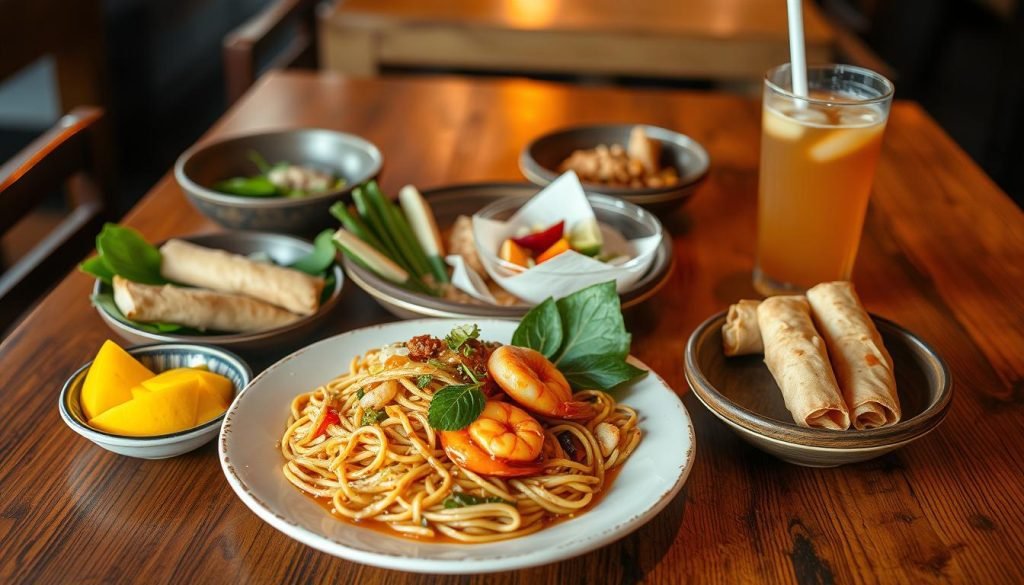
By choosing the right sides and focusing on food presentation, your Pad Thai can be as good as a restaurant’s.
| Side Dish | Description | Complementary Drink |
|---|---|---|
| Thai Spring Rolls | Fresh vegetables wrapped in rice paper | Thai iced tea |
| Mango Sticky Rice | Sweet dessert with mango and coconut rice | Chilled white wine |
| Green Papaya Salad | Crunchy and spicy salad | Lime soda |
| Thai Coconut Soup | Rich soup with coconut milk and spices | Light beer |
| Satay Skewers | Grilled, marinated meats with peanut sauce | Fresh lemonade |
Health Benefits of Pad Thai
Pad Thai is tasty and good for you. It’s full of nutrients from its ingredients. Let’s look at what makes it healthy and how you can make it your own.
Nutritional Value Overview
Prepackaged Pad Thai (311 g) has 429 calories. It’s a bit high but not too much. It has 82 g of carbs, which is 29% of what you need daily.
It also has 4.04 g of fiber and 26 g of sugars. With 20 g of protein, it helps keep your muscles strong.
| Component | Amount | Daily Value (DV) |
|---|---|---|
| Calories | 429 | – |
| Carbohydrates | 82 g | 29% |
| Fiber | 4.04 g | – |
| Sugars | 26 g | – |
| Protein | 20 g | 38% |
| Total Fat | 2.46 g | 6% |
| Saturated Fat | 0.995 g | 5% |
| Cholesterol | 40.4 mg | 13% |
| Calcium | 71.5 mg | 4% |
| Iron | 1.21 mg | 6% |
| Sodium | 659 mg | 31% |
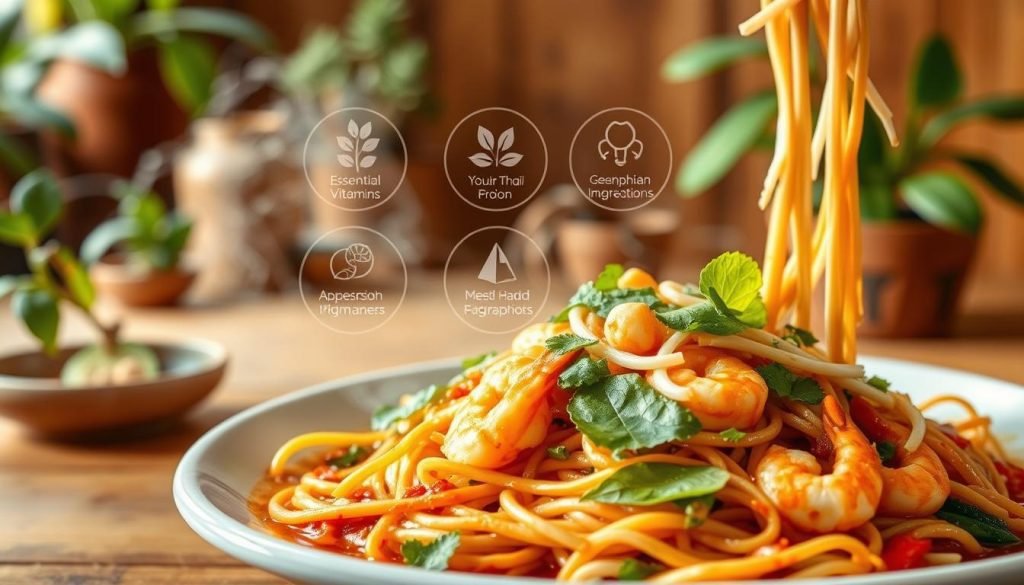
Pad Thai also has vitamins and minerals. It has vitamin A from eggs, selenium from tofu, and fiber from mung bean sprouts. This makes it a healthy choice.
Customizing for a Healthier Version
To make Pad Thai even healthier, try a few changes. Use brown rice noodles for more fiber. This can also lower the glycemic index.
Switch to low-sodium sauces. Use less fish sauce and soy sauce to cut down on sodium. Adding more veggies like bell peppers, broccoli, and spinach boosts fiber and vitamins. This makes it a top choice for healthy Thai food.
By tweaking these details, you can make meals that are both tasty and nutritious. This way, you can enjoy a variety of healthy dishes.
Tips for Making the Best Pad Thai
Making perfect Pad Thai needs focus on Authentic Cooking Techniques and the right Cooking Tips. Learning to cook Pad Thai is very rewarding. We’ll share important methods and tips to avoid mistakes, making your Thai dishes great.
Key Cooking Techniques
One key Thai Cooking tip is to control the heat. Pad Thai cooks fast, so heat your wok or skillet well before adding food. Also, soak flat rice noodles in cold water for 2 to 3 hours for the best softness. Or, soak in boiling water for 10 minutes and then rinse in cold water.
For a real Pad Thai sauce, mix tamarind, sugar, rice vinegar, and fish sauce. Use 2 tbsp tamarind, 3 tbsp sugar, 1 tbsp fish sauce, 1.5 tbsp oyster sauce, and 1 tbsp water. Stir-fry in two batches to mix the sauce well and prevent noodles from getting sticky.
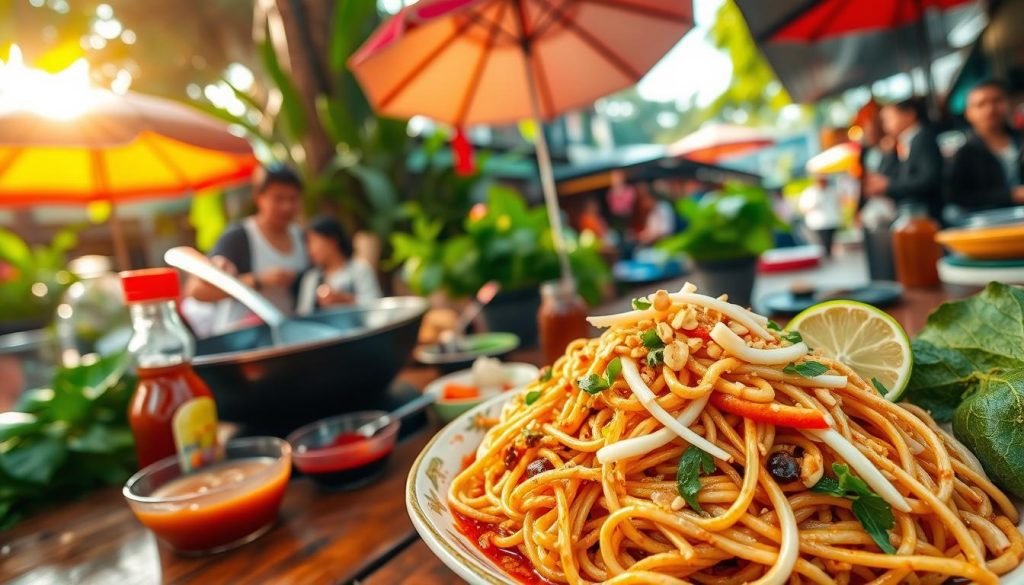
Avoiding Common Mistakes
Many people struggle with noodle texture and flavor balance. Use long, wide rice noodles instead of short ones. Also, use about 10 to 12 tablespoons of oil for the whole recipe to cook everything evenly.
Don’t overcrowd the pan. Cook in smaller portions, like one serving at a time, to keep flavors fresh. Remember, the sauce’s balance can change with different tamarind or fish sauce brands. So, taste and adjust as needed.
By following these Cooking Tips and Authentic Cooking Techniques, you can make delicious Pad Thai every time.
Where to Find the Best Pad Thai
Looking for the best Pad Thai is a fun trip. You can find it in Thai restaurants and street food guides. Whether in America or Bangkok, you’re in for a treat.
Popular Restaurants in America
Thai restaurants in America offer great Pad Thai. You don’t need to travel far. Chicago has many places to try it.
- Immm Rice & Beyond: Offers lunch deals with up to three proteins and rice for $12 or less.
- Andy’s Thai Kitchen: Chef Andy Aroonrasameruang creates a unique menu.
- J.J. Thai Street Food: It’s small, with only 28 seats.
- Arun’s: They have a changing pre-fixe menu of Thai dishes.
- Sticky Rice: They introduce new dishes every few weeks.
Traveling in America can also lead to great finds. For example:
- Herb: They have prix fixe menus up to $85 for seven courses.
- Opart Thai House: They serve many Thai dishes.
- Rainbow Thai Cuisine: They have 11 noodle dishes.
- Ghin Khao Eat Rice: They focus on Northern Thai snacks.
- Same Same: They serve southern Thai-style fried chicken.
- Tuk Tuk Thai Isan Street Food: They offer dishes from Thailand’s Isan region.
Street Vendors to Check Out
Bangkok’s street food is amazing. Guides often recommend top vendors for authentic Pad Thai:
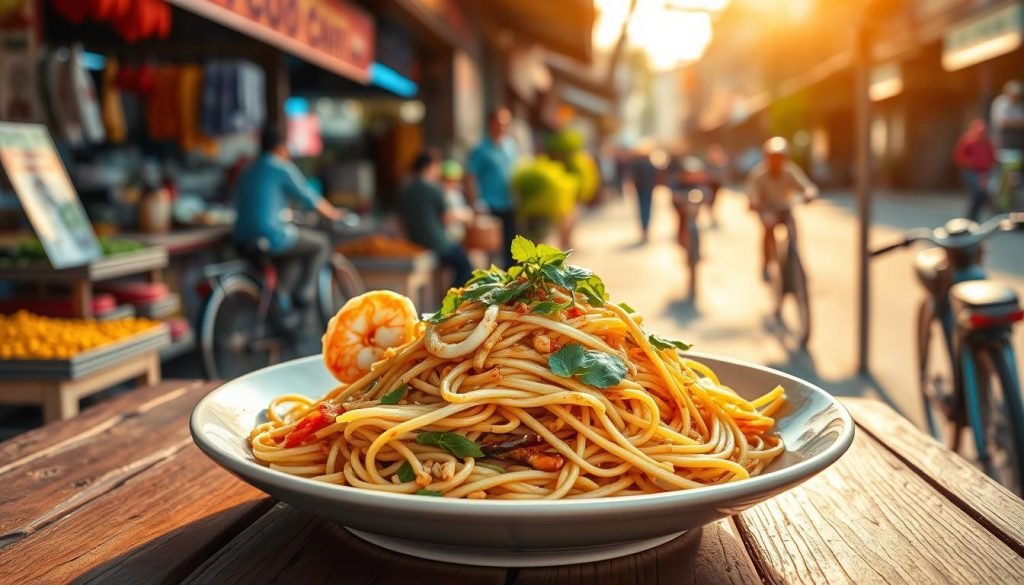
- Thipsamai Pad Thai: Open since 1966 and in the Bangkok Michelin Bib Gourmand Guide in 2018.
- Lung Pha: They’ve been serving Pad Thai for over 60 years.
- Sawasdee Ratchawat: Almost 100 years old.
- Pad Thai Sawoey: Won Best Pad Thai in 2003.
- Loong Piak: The cheapest in Bangkapi.
These places offer great Pad Thai and cultural experiences. Whether in America or Bangkok, you’ll find amazing dishes.
Conclusion: Enjoying Your Homemade Pad Thai
You’ve explored the world of Thai Recipes and are ready to make Pad Thai at home. You now have the tips and techniques to make this dish. Home Cooking brings joy and satisfaction, knowing each dish is special.
Preparing the noodles and choosing the right proteins is key. Mastering the stir-fry is also important. Each ingredient, from noodles to peanuts, adds to the dish’s flavor.
Don’t be afraid to try new things in your cooking. Pad Thai is great for sharing with loved ones. Enjoy making it and the praise you’ll get. Happy cooking!